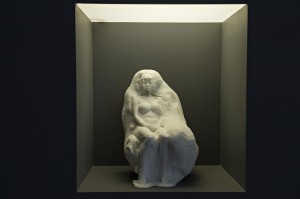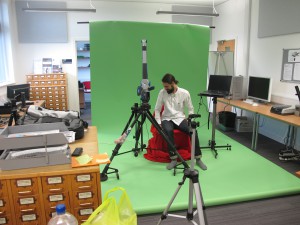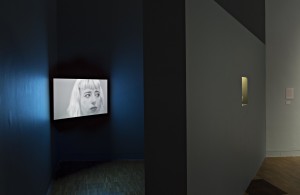August 11, 2014, by Matt Davies
Model Making: part one by DHC Leonardo Fellow James E Smith
I have been juggling numerous new projects recently but I thought it was about time I followed up my introduction post with something about my piece ‘Model’, made during the first months of my residency at the DHC and currently on show at The Collection in Lincoln until September 7th.
Having been commissioned by The Collection to produce a new work for the exhibition Opem 3, I embarked on some tests with the DHC’s Faro Quantum Arm 3D scanner under the guidance of former DHC volunteer Craig Goodere. Once familiar with the workings of the scanner and having done some experiments on scanning myself and some volunteers, I placed an advert on the Arts Council’s jobs listings websites calling for someone who was willing to have their entire body scanned while the process was simultaneously filmed.
It was important that the applicant wasn’t somebody I knew personally as I wanted the situation between me and the sitter to be unfamiliar. From over thirty email responses I picked a Spanish woman named Marta, a student at the University of Essex studying an MA in Gallery Studies and Critical Curating. After a few emails back and forth and a chat on Skype, a day was arranged for Marta to travel to Nottingham to be scanned.
I had an idea how I wanted the film to look, so on the day I set the cameras up around Marta accordingly. She was keen to have an input in this and it became quite a collaborative process. During the scan I didn’t want to direct her too much and wanted her to feel as relaxed as possible, so giving over some control to her felt quite organic. She asked if she should avoid looking into the cameras, and I told her that she should do whatever she felt comfortable with.
The cameras I used where Canon Digital SLRs. Two 550Ds, a 5D and the DHC’s 7D. These cameras have a limit of only 12 minutes (4.7GB) recording time as they are designed to be still image cameras with the capability to record HD video being a bonus but because of their relatively low price, in comparison to video specific cameras with interchangeable lenses, artists and filmmakers on a budget have embraced them. Also, by using third party software like Magic Lantern installed on the SD card on my 550D, the features can be expanded to rival much more expensive video cameras. This software hosts a multitude of useful features like focus peaking and frame rate override which is very useful for doing time-lapse. On this occasion I didn’t really need to use any of Magic Lantern’s features, and to free myself of the hassle of having to keep track of restarting the recording function on each camera every twelve minutes, I recruited the help of artist Alice Gale-Feeny. Alice never appears in the video as I have edited out the few moments when she walks into shot, but interestingly I think the viewer may still be able to tell that there is someone else present in the room through Marta’s behavior.
I filmed the whole one hour forty minute procedure in the DHC. With the help of DHC Manager Matt Davies, I constructed a plain backdrop so that the subject would be isolated within the shots, and to give the appearance of a photographic studio. There is one shot over Marta’s shoulder, which reveals the computer capturing the data, and running the DHC’s 3D scan software, Polyworks.
I synchronised all of the footage in sequences using Final Cut Pro 7’s multi-cam edit feature. I was able to see all of the angles at the same time and could click on the view that I wanted to cut to and I did this pretty much in one go, insofar as I didn’t watch the same sequences over and over. Once I had synced them I just watched the different angles simultaneously and tried to keep the shots changing, not lingering on any one angle for too long unless I really felt I needed to. As I was editing I wondered how long the viewer would have to watch before coming to a conclusion about what was taking place. Sometimes a particular shot doesn’t have the scanner or me in so Marta is sat alone; what would a viewer seeing that moment in the piece think they were seeing? how long could the video hold their attention if it seemed nothing was happening?
Model consists of two components- elements if you like – the video of the scanning taking place, and a 3D printed sculpture made using the data from the scan. In my next post I’ll be sharing with you the processes behind making the 3D printed element of the work.
No comments yet, fill out a comment to be the first




Leave a Reply